The NASA Electronic Parts and Packaging (NEPP) '02 Workshop
The NASA Electronic Parts and Packaging (NEPP) '02 Workshop
The NASA Electronic Parts and Packaging (NEPP) '02 Workshop
You also want an ePaper? Increase the reach of your titles
YUMPU automatically turns print PDFs into web optimized ePapers that Google loves.
Abstracts ________________________<br />
Session 7 – Low Temperature Environments II<br />
Low Temperature <strong>Electronic</strong>s for Next Generation Space<br />
Telescope<br />
Roger Stone <strong>and</strong> Matthew Jurotich: Next Generation Space<br />
Telescope, <strong>NASA</strong> Goddard Space Flight<br />
Center, Greenbelt, MD 20771<br />
Abstract<br />
<strong>The</strong> Next Generation Space Telescope (NGST) will help answer<br />
such basic questions as: What is the history of the universe? What<br />
is its ultimate fate? Where did galaxies, stars, <strong>and</strong> planets come<br />
from, <strong>and</strong> how do they evolve over time? Answers to these age-old<br />
questions about the nature of our universe have eluded humankind<br />
for centuries. Scientists <strong>and</strong> engineers are designing a new<br />
observatory, the NGST, to shed much anticipated light on these<br />
celestial mysteries. NGST will be more powerful than any<br />
telescope ever built <strong>and</strong> will allow us to see even farther into space<br />
<strong>and</strong> time. NGST will have a 6-7 meter diameter deployable primary<br />
mirror operating in the 0.6 to 28 micron wavelength optimized for<br />
near infrared. It will be passively cooled to less than 50K <strong>and</strong> will<br />
be stationed at the thermally stable Second Lagrange point (L2) in<br />
a halo orbit. This will allow for radiative cooling of the detectors <strong>and</strong><br />
the telescope to provided the necessary NIR sensitivity. NGST,<br />
which is currently being designed with an expected launch date of<br />
2009 will succeed the Hubble Space Telescope. <strong>The</strong> mission life is<br />
five years with a 10-year lifetime goal.<br />
A variety of low temperature electronics will be required to support<br />
the NGST Instrument detectors (which operate at < 30 K),<br />
Instrument mechanisms <strong>and</strong> the primary mirror focus. <strong>The</strong><br />
telescope primary mirror itself will operate at < ~ 45 K to permit<br />
active thermal stabilization, <strong>and</strong> allow for detector radiative cooling.<br />
A sunshield is utilized by the spacecraft which will have an inner<br />
surface < ~ 100 K. Low temperature electronics used by NGST<br />
includes detectors, a variety of different multiplexers, motor<br />
controllers, possible Analog to Digital Converters <strong>and</strong> power<br />
converters. This presentation explores various aspects of planned<br />
<strong>and</strong> potential low temperature electronics <strong>and</strong> the pertinent<br />
requirements.<br />
Speaker Biographies<br />
Matthew M. Jurotich<br />
Education: A.B. Physics, Rockhust College, Kansas City Mo. MS<br />
<strong>and</strong> PhD, Mathematics, St. Louis University, St. Louis Mo.<br />
Experience: After completing his PhD, Dr. Jurotich worked for<br />
NOAA/NESDIS in orbit <strong>and</strong> attitude determination <strong>and</strong> on-orbit<br />
instrument calibration. He joined <strong>NASA</strong>/GSFC in 1989 <strong>and</strong> had two<br />
payloads on the HST first servicing mission. That work earned him<br />
a <strong>NASA</strong> Exceptional Service Medal. Following HST, he was<br />
Instrument Systems Manager for L<strong>and</strong>sat <strong>and</strong> EO-1. Dr. Jurotich<br />
joined the Next Generation Space Telescope (NGST) project in<br />
1998 <strong>and</strong> is the Chief Systems Engineer for NGST's Integrated<br />
Science Instrument Module (ISIM).<br />
Semiconductor Device Options for Low Temperature<br />
<strong>Electronic</strong>s<br />
R.K. Kirschman: Consulting Physicist, Mountain View, CA<br />
R.R. Ward: GPD Optoelectronics Corp., Salem, NH<br />
Abstract<br />
<strong>NASA</strong> <strong>and</strong> other organizations have an interest in low-temperature<br />
power electronics for spacecraft that will experience very low<br />
temperatures in deep space <strong>and</strong> on cold Solar System bodies.<br />
<strong>The</strong>re are also potential applications for low-temperature power<br />
electronics in industrial <strong>and</strong> commercial areas such as magnetic<br />
resonance imaging, motors <strong>and</strong> generators, power transmission<br />
<strong>and</strong> distribution, <strong>and</strong> energy storage that incorporate cryogenic<br />
cooling <strong>and</strong> possibly superconductor hardware.<br />
Depending on the particular application, there are a number of<br />
options for the semiconductor material on which to base the diodes<br />
<strong>and</strong> transistors to be used in such low-temperature power<br />
electronics. <strong>The</strong>re have been a number of studies <strong>and</strong><br />
demonstrations on silicon-based low-temperature power devices<br />
<strong>and</strong> circuits, which have shown good performance down to about<br />
80 K. <strong>The</strong>re has also been some work on InGaAs power transistors<br />
for lower-temperature operation, to 20 K. However, we believe that<br />
other semiconductor materials might offer benefits, both in<br />
performance <strong>and</strong> practicality, for low-temperature operation. Thus<br />
we believe that it is worthwhile to consider alternative<br />
semiconductor materials as the basis of cryogenic power devices,<br />
specifically germanium (Ge) <strong>and</strong> silicon-germanium (SiGe).<br />
Roger E. Stone Investigation <strong>and</strong> development of specialized semiconductor<br />
Education: BSEE from Colorado State University, Fort Collins;<br />
MSEE from California State University at Fullerton. California<br />
Registered Professional Engineer (Electrical Engineering)<br />
Experience: After graduating with his undergraduate degree, Mr.<br />
Stone work for the Naval Fleet Analysis Center in Corona, CA<br />
developing shipboard instrumentation to support weapons systems<br />
performance analysis. After competing his master's degree Mr.<br />
Stone developed telemetry ground stations for Naval missiles. <strong>The</strong><br />
last major work assignment with the Navy was test director for the<br />
Tactical Air Combat Training Systems (Top Gun). <strong>NASA</strong><br />
experience includes serving as Chief Electrical Systems<br />
Engineering for the EOS-Terra Spacecraft, Electrical System Lead<br />
for the Geoscience Laser Altimeter System <strong>and</strong> currently as Chief<br />
Electrical Systems Engineer for the Next Generation Space<br />
Telescope.<br />
21<br />
devices based on Ge is already underway. Ge offers the<br />
advantages of low p-n junction forward voltage <strong>and</strong>, with proper<br />
device design, operation to the deep cryogenic temperatures<br />
required for some applications. Another material, SiGe, is also very<br />
attractive for cryogenic power electronics because of its<br />
compatibility with existing Si device fabrication <strong>and</strong> its additional<br />
design flexibility afforded by b<strong>and</strong>-gap engineering. Combinations<br />
of Si, Ge, <strong>and</strong> SiGe should enable optimization of diodes <strong>and</strong><br />
transistors for cryogenic power applications by taking advantage of<br />
the best features of each material individually <strong>and</strong> in combination.<br />
Speaker Biography<br />
R<strong>and</strong>all Kirschman earned the B.S. in Engineering Physics from<br />
the University of California (Berkeley) in 1966 <strong>and</strong> the Ph.D. in<br />
Physics <strong>and</strong> Electrical Engineering from the California Institute of<br />
Technology in 1972. His thesis research involved superconductive<br />
devices. As an undergraduate he was honored with memberships<br />
in Phi Beta Kappa, Sigma Xi <strong>and</strong> Tau Beta Pi.



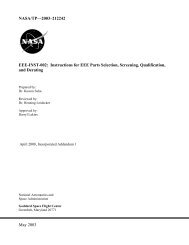

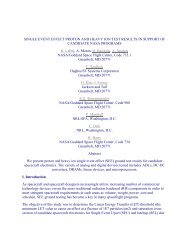
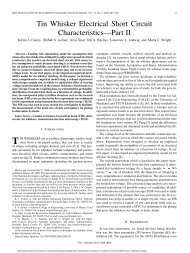
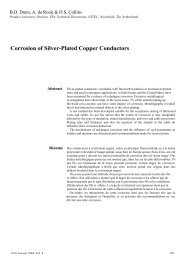
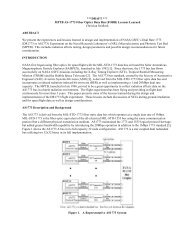

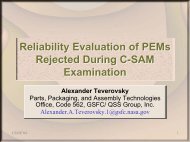
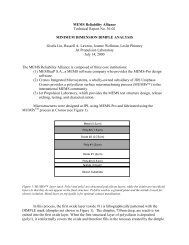
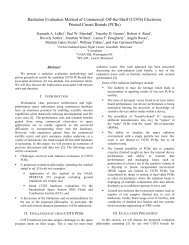
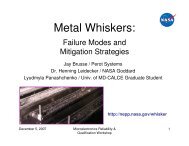
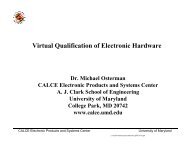
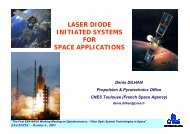
![mil-std-2223 [test methods for insulated electric wire] - NEPP](https://img.yumpu.com/4036001/1/190x249/mil-std-2223-test-methods-for-insulated-electric-wire-nepp.jpg?quality=85)